Blog
The thirteen women behind Veronica Jackson’s “BLACKTIVISTS” series
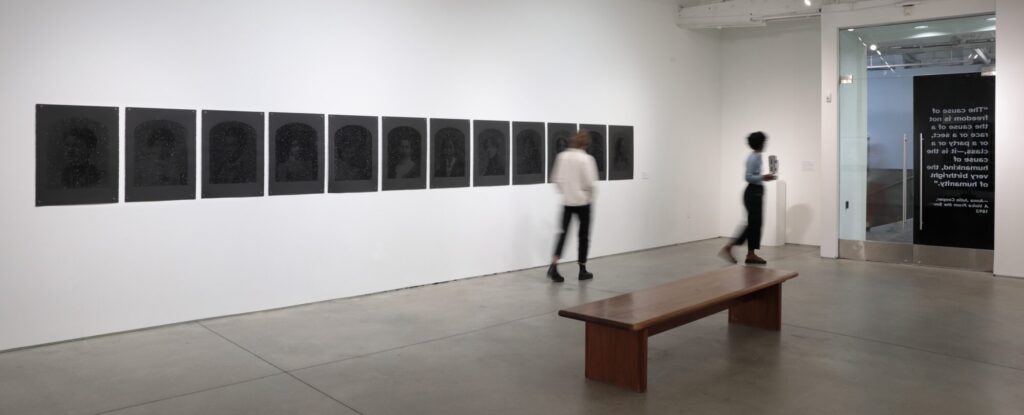
When first stepping into Veronica Jackson’s exhibition at VisArts, visitors are met with a striking series of portraits. Together, these silk-screened prints make up Jackson’s BLACKTIVISTS series, depicting thirteen relatively unknown and overlooked Black women activists.
Most of these women were born during the time of enslavement in the United States, and some were enslaved at birth. Yet, despite, or because, of their social circumstances, they championed human rights for Black folks at a time when their own racialized and gendered existence remained in jeopardy.
In this series, the technique of silk-screening black ink on black paper symbolizes the invisibility, devaluation, and barely acknowledged essence of Black women’s stories. Incorporating a layer of extra-fine black glitter adds reflectivity and sparkle to the images. Literally this method brings attention to the likeness depicted in each woman’s portrait. Conceptually it highlights their previously unknown, ignored, yet important contributions to American history.
Whether you’re planning a visit to VisArts’ True F. Luck Gallery or are looking to dive deeper after exploring A CONSTELLATION OF BLACKNESS, here’s your chance to learn more about these remarkable Black women activists.
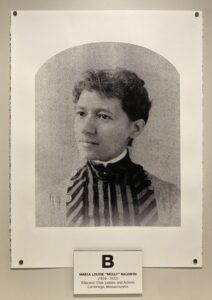 MARIA LOUISE “MOLLY” BALDWIN (1856 –1922)
MARIA LOUISE “MOLLY” BALDWIN (1856 –1922)
Civic Leader, Educator, and Activist
Cambridge, Massachusetts
In Cambridge, Molly Baldwin was hired to teach at the Agassiz School—a well-regarded public school attended by the children of Harvard University professors and many of the old Cambridge families. She was appointed principal in 1889, becoming the first Black female principal in Massachusetts and the Northeast. In 1916, Baldwin was made master of the school; she was one of only two women in the Cambridge school system and the only Black person (regardless of gender) in New England to hold such a position. Under her leadership, it became one of the best schools in the city. She introduced new methods of teaching mathematics and began art classes. Baldwin was the first to introduce the practice of hiring a school nurse. Her school was the only one in the city of Cambridge to establish an “open-air” classroom.
Sources: National Park Service; peoplepill
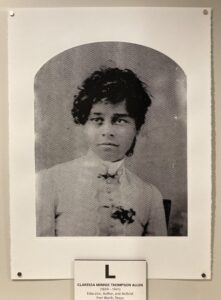 CLARISSA MINNIE THOMPSON ALLEN (1859 – 1941)
CLARISSA MINNIE THOMPSON ALLEN (1859 – 1941)
Author, Educator, and Activist
Fort Worth, Texas
During her years in Texas, Thompson served as an active member of the Colored Division of the Woman’s Christian Temperance Union—an organization that endorsed the women’s suffrage movement and numerous progressive causes related to welfare and public health. Thompson spent the duration of her career and her adult life stressing the importance of education for women, particularly Black women. Through her teaching career, writing, and organizational ties, Thompson committed herself to ensuring that Black women would receive better opportunities than they had in the past.
As a writer, Thompson authored short stories and poetry. She wrote fictional accounts based on the lives of actual wealthy Black families. The Boston Advocate serialized one of her best-known stories, Treading the Winepress; or, A Mountain of Misfortune in 1885 and 1886. Thompson also published her poetry and letters for Black newspapers in Texas under the pseudonym Minnie Myrtle. In depicting the struggles of her characters, Thompson found a way to both acknowledge and celebrate positive aspects of Black womanhood through her literary work.
Source: Alexander Street
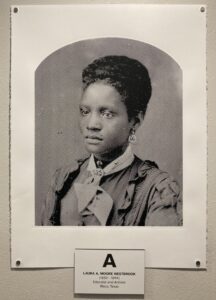 LAURA A. MOORE WESTBROOK (1859 – 1894)
LAURA A. MOORE WESTBROOK (1859 – 1894)
Educator and Activist
Waco, Texas
Although born enslaved in southwest Tennessee, Laura Westbrook was educated by one of Oberlin College’s finest instructors. After only five years of dedicated study, she became an educator at the young age of 11 by tutoring other African American girls in her community. After college and marriage, she made a home in Waco, Texas which included a career of public education and activism—notably for women’s civil rights. Westbrook was a member of the Woman’s Christian Temperance Union. In 1888, it became the first chapter in the South to take the radical step of endorsing women’s suffrage. Recognized for being passionate about her work, colleagues described Westbrook as aggressive when defending people of her race. She was acknowledged to be a firm believer of the true, the pure, and the beautiful. Westbrook lived a meaningful and active life, albeit a short one. She died in 1894 at the age of 35.
Source: Alexander Street
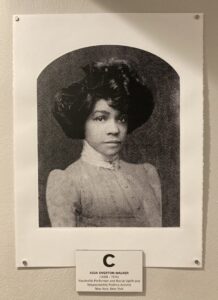 AIDA OVERTON WALKER (1880 – 1914)
AIDA OVERTON WALKER (1880 – 1914)
Vaudeville Performer and Racial Uplift and Respectability Politics Activist
New York, New York
Based in New York City, Aida Overton Walker was a Black vaudeville performer engaged in a campaign to restructure and re-present how Black Americans were viewed and perceived by society. These acts reflect her embodiment of racial uplift—a project with the purpose to deliver positive images of Black people. The perceived need to uplift the race was a response to the anti-Black, racist environment prevalent at the turn of the 20th century. Overton Walker’s interpretation of racial uplift came in the form of restructuring identity, representation, and respectability of Black people—particularly Black women in popular theater—through her choreography, dance, onstage performances, and her visual presence during years of pervasive racism. Specifically Overton Walker was determined to articulate her brand of respectability politics while claiming her right to choose the theater as a profession. She consistently worked toward these goals from the beginning of her onstage career in 1897 to her premature death in 1914.
Source: escholarship.org
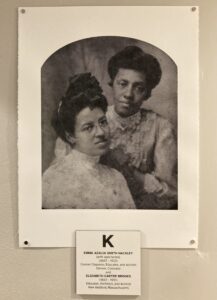 EMMA AZALIA SMITH HACKLEY (1867 – 1922)
EMMA AZALIA SMITH HACKLEY (1867 – 1922)
Concert Soprano, Educator, Newspaper Editor, and Activist
Denver, Colorado
ELIZABETH CARTER BROOKS (1867 – 1951)
Architect, Educator, and Activist
New Bedford, Massachusetts
Emma Azalia Smith Hackley was a Black singer and political activist based in Denver, Colorado. She was a child prodigy learning to play the piano at three, as well as taking private voice, violin, and French lessons. In 1900 Hackley received her music degree from Denver University, and in 1905-1906 studied voice in Paris with a former Metropolitan Opera star. Active in Denver’s Black education, civic, and social life, Hackley worked as an elementary school teacher for eighteen years, founded the Colored Women’s League, and served as executive director of its local branch. Despite her stellar training, Hackley did not pursue a professional career. Instead she spent much of the rest of her life training a younger generation of singers such as Marian Anderson. Hackley published her own collection of music entitled Colored Girl Beautiful. Later she turned her attention to Black folk music and organized the Folk Songs Festivals movement in Black schools and churches across the South.
Elizabeth Carter Brooks envisioned equality as she worked as an educator, social activist, and architect. Born in New Bedford, Massachusetts to a formerly enslaved mother, Brooks graduated from New Bedford High School and then continued her education in architecture at the Swain Free School of Design. She went on to study at New Bedford’s Harrington Normal School for Teachers, where she became its first Black graduate. In 1901 Brooks became the first Black woman hired as a public-school teacher in New Bedford.
Her work in the Black women’s club movement, in architecture, and in real estate development were grounded in her social activism. She helped form the Northeastern Federation of Colored Women’s Clubs, founded the New Bedford Home for the Aged, and designed its permanent home on Chancery Street. Through her teaching, organizing and building, Elizabeth Carter Brooks enriched the lives of New Bedford’s students, elderly, and people of color.
Sources: Black Past; Lighting the Way
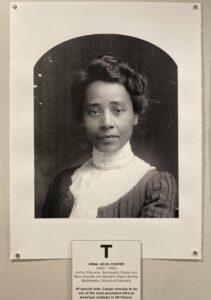 ANNA JULIA COOPER (1858 – 1964)
ANNA JULIA COOPER (1858 – 1964)
Author, Educator, Sociologist, Orator, and Black Equality and Women’s Rights Activist
Washington, DC
“The cause of freedom is not the cause of a race or a sect, or a party or a class—it is the cause of humankind, the very birthright of humanity.” — Anna Julia Cooper, A Voice From the South by a Black Woman of the South, 1892
Anna Julia Haywood Cooper was born enslaved in Raleigh, North Carolina. She attended Oberlin College, Ohio on a scholarship, earning a bachelor’s in 1884 and a master’s degree in mathematics in 1887. After graduation, Cooper worked at Wilberforce University and Saint Augustine’s before moving to Washington, DC to teach at Washington Colored High School.
In 1892 she published her first book, A Voice from the South by a Black Woman of the South. In addition to calling for equal education for women, the book advanced Cooper’s assertion that educated Black women were necessary for uplifting the entire Black race. The book of essays gained national attention, and Cooper began lecturing across the country on topics such as education, civil rights, and the status of Black women.
Cooper also established and co-founded several organizations to promote Black civil rights causes. Before 1946, the YWCA and YMCA did not accept African American members. As a result, Cooper created “colored” branches to provide support for young Black migrants moving from the South to Washington, DC.
Of special note, Cooper remains to be one of the most prominent Black scholars in US history.
Source: Black History
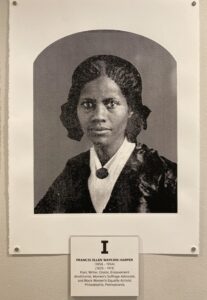 FRANCIS ELLEN WATKINS HARPER
(1825 – 1911)
FRANCIS ELLEN WATKINS HARPER
(1825 – 1911)
Poet, Writer, Orator, Abolitionist, Suffragist, and Black Women’s Equality Activist
Philadelphia, Pennsylvania
As a poet, author, and lecturer, Frances Ellen Watkins Harper was a household name in the nineteenth century. She was an influential abolitionist, suffragist, and reformer that co-founded the National Association of Colored Women’s Clubs. Harper traveled across the United States and Canada as a lecturer. After her first speech entitled, “The Elevation and Education of our People,” she was hired as a traveling orator for various organizations including the Maine Anti-Slavery Society and the Pennsylvania Anti-Slavery Society. In addition to her anti-slavery lectures, Harper was committed to the struggle for women’s rights and the temperance movement. She included her observations from her travels in her writings and began to publish novels, short stories, and poetry focused on issues of racism, feminism, and classism. In 1859, Harper published a short story in the Anglo-African Magazine called “The Two Offers.” This short story about women’s education was the first short story published by a Black woman.
Source: National Women’s History Museum
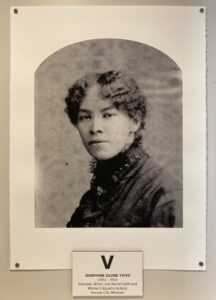 JOSEPHINE SILONE YATES (1852 – 1912)
JOSEPHINE SILONE YATES (1852 – 1912)
Writer, Educator, and Racial Uplift and Women’s Equality Activist
Kansas City, Missouri
Writer, teacher, and civil rights activist Josephine Silone Yates was the only Black student in her class and the first to graduate from Rogers High School in Newport, Rhode Island in 1877. She was selected class valedictorian. Yates’s high school teachers encouraged her to attend university but instead she chose Rhode Island State Normal School, a teacher’s college. Again Yates graduated as the only African American student in 1879. For most of her life she wrote while teaching. Yates penned newspaper and magazine articles often under the alias R.K. Potter. By 1900 she expanded her writing to include poetry. Yates was involved in clubs and organizations that fought for racial and social change. She helped to organize the Kansas City Women’s League and was its first president in 1893. After the National Association of Colored Women (NACW) was established in 1896, Yates became one of its most dedicated supporters.
Source: Black Past
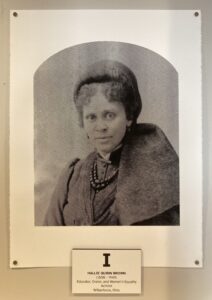 HALLIE QUINN BROWN (1850 – 1949)
HALLIE QUINN BROWN (1850 – 1949)
Orator, Educator, Author, and Women’s Equality Activist
Wilberforce, Ohio
Hallie Quinn Brown was a Black orator and educator who pioneered the movement for Black women’s clubs in the United States. Brown was the daughter of formerly enslaved parents. In 1870 she entered Wilberforce University in Ohio and after graduating in 1873, she taught in plantation and public schools in Mississippi, South Carolina, and Ohio. After public school teaching, Brown served as a principal of Tuskegee Institute in Alabama under founder Booker T. Washington. In 1893 she was appointed professor of elocution at Wilberforce University, but her teaching duties were limited by her frequent and extensive lecture tours, notably in Europe. Her orations on Black life and temperance in the United States were especially popular in Great Britain, where she appeared twice before Queen Victoria. Brown was a speaker at the 1895 convention of the World’s Woman’s Christian Temperance Union in London and a representative of the United States at the International Congress of Women in 1899.
Source: Britannica
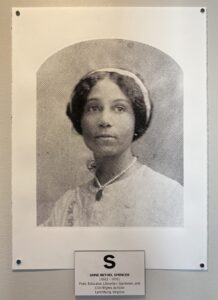 ANNE BETHEL SPENCER (1882 – 1975)
ANNE BETHEL SPENCER (1882 – 1975)
Poet, Educator, Librarian, Gardener, and Civil Rights Activist
Lynchburg, Virginia
Anne Bethel Spencer was a Black poet, teacher, civil rights activist, librarian, and gardener. She was a prominent figure of the Harlem Renaissance despite living in Virginia for most of her life, far from the center of the movement in New York. Spencer holds an important place as a widely anthologized poet, and was the first Virginian and one of three Black women included in the highly influential Norton Anthology of Modern Poetry (1973). As a civil rights activist for equality and educational opportunities, she and a few close friends revived the Lynchburg chapter of the NAACP. In association with James Weldon Johnson, the branch became fully active with ninety-six members as of July, 1918. Spencer’s home on Pierce Street in Lynchburg became an important center and intellectual salon for guests and dignitaries such as Langston Hughes, Marian Anderson, George Washington Carver, Thurgood Marshall, Martin Luther King Jr., James Weldon Johnson, and W. E. B. Du Bois.
Source: Wikipedia
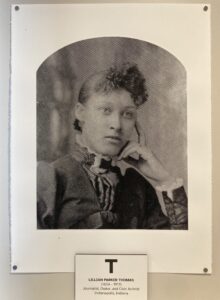 LILLIAN PARKER THOMAS (1854 – 1917)
LILLIAN PARKER THOMAS (1854 – 1917)
Journalist, Orator, and Civic Activist
Indianapolis, Indiana
Lillian Parker Thomas was born in Chicago, Illinois, grew up in Oshkosh, Wisconsin, and settled in Indianapolis, Indiana. She became the first Black woman to write for the white Indianapolis press and the only woman on the editorial staff of the Indianapolis Freeman, the first illustrated Black national weekly newspaper. Thomas spent her life writing, speaking, and educating women and men, often discussing issues surrounding the health of the Black community and education for Black women. In addition to civil rights work, Thomas concentrated on suffrage as a means of helping Black women. She was the Indiana State Organizer for the National Association of Colored Women (NACW), an entity that focused on issues such as suffrage, lynching, and civil rights. Thomas also worked closely with Ida B. Wells and the National Afro-American Civil Rights Organization. Her work reflected a commitment to advance the position of Black Americans, particularly women, through education and a chance to change society for the better.
Source: Alexander Street
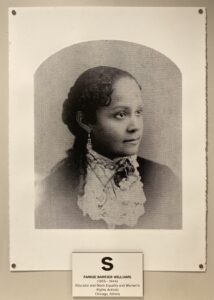 FANNIE BARRIER WILLIAMS (1855 – 1944)
FANNIE BARRIER WILLIAMS (1855 – 1944)
Educator and Black Equality and Women’s Rights Activist
Chicago, Illinois
Fannie Barrier Williams believed that her childhood experiences of “social equality” in Brockport, New York ill-prepared her for the racism that she faced later in life. Her growing awareness of the unfair treatment Black women received led her to pursue a lifetime of activism, and strengthened her commitment to improving their lives. Recognizing the lack of services available to Black women, Williams established the National Federation of Afro-American Women with Mary Church Terrell in 1895 and helped found the National Association of Colored Women (NACW) in 1896. These organizations provided kindergartens, mothers’ groups, sewing classes, childcare centers, employment bureaus, and savings banks for women who would not have had access to them elsewhere. Williams befriended W. E. B. Du Bois and was among the founders of the NAACP. Her work to secure women’s rights was recognized upon selection as the only Black woman to eulogize Susan B. Anthony at the National American Women’s Suffrage Association convention in 1907.
Source: Rochester Regional Library Council